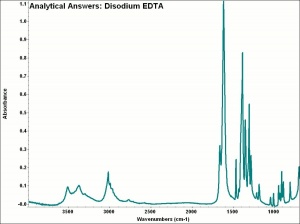Difference between revisions of "EDTA"
(username removed) |
|||
| Line 1: | Line 1: | ||
== Description == | == Description == | ||
| − | An acronym for ethylenediamine tetraacetic acid and many of the metal salts derived from this acid. The metal salts, such as [ | + | An acronym for ethylenediamine tetraacetic acid and many of the metal salts derived from this acid. The metal salts, such as [[calcium]], [[sodium]], etc., are generically called edates. EDTA has colorless crystals that are slightly soluble in water and insoluble in organic solvents. EDTA is a strong chelating agent used to remove metallic salts from solutions. The use of EDTA has had some success in cleaning stains and crusts from stone. Its ability to selectively remove stains is determined by the number and type of attached metal salts. For example, disodium EDTA is acidic and quickly solubilizes [[calcite]], while tetrasodium EDTA is basic and better dissolves [[gypsum]] (Thorn, 1993). EDTA is also used in detergents, soaps, shampoos, textiles, and food. |
== Synonyms and Related Terms == | == Synonyms and Related Terms == | ||
Revision as of 19:21, 14 January 2014
Description
An acronym for ethylenediamine tetraacetic acid and many of the metal salts derived from this acid. The metal salts, such as Calcium, Sodium, etc., are generically called edates. EDTA has colorless crystals that are slightly soluble in water and insoluble in organic solvents. EDTA is a strong chelating agent used to remove metallic salts from solutions. The use of EDTA has had some success in cleaning stains and crusts from stone. Its ability to selectively remove stains is determined by the number and type of attached metal salts. For example, disodium EDTA is acidic and quickly solubilizes Calcite, while tetrasodium EDTA is basic and better dissolves Gypsum (Thorn, 1993). EDTA is also used in detergents, soaps, shampoos, textiles, and food.
Synonyms and Related Terms
ethylenediamine tetraacetic acid; n,n'-1,2-ethanediylbis(n-carboxymethyl)-glycine; edetic acid; sodium EDTA
Other Properties
Slightly soluble in water. Insoluble in organic solvents.
| Composition | C10H16N2O8 |
|---|---|
| CAS | 60-00-4 |
| Molecular Weight | mol. wt. = 292.2 |
Hazards and Safety
Contact with concentrated EDTA may cause skin and eye irritation.
International Chemical Safety Card
Additional Information
A.Thorn "The Impact of Disodium EDTA on Stone" ICOM Preprints, Washington DC, 1993, p. 357-363.
Authority
- Richard S. Lewis, Hawley's Condensed Chemical Dictionary, Van Nostrand Reinhold, New York, 10th ed., 1993
- Richard C. Wolbers, Nanette T. Sterman, Chris Stavroudis, Notes for Workshop on New Methods in the Cleaning of Paintings, J.Paul Getty Trust, Los Angeles, 1990
- Marie Svoboda, Conservation Survey Index, unpublished, 1997
- The Merck Index, Susan Budavari (ed.), Merck Research Labs, Whitehouse Station, NJ, 12th Edition, 1996 Comment: entry 3490
- Website address 1 Comment: conservation termlist at www.hants.org.uk/museums

